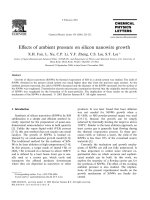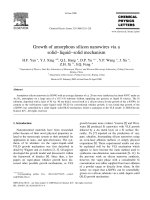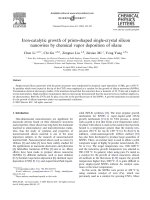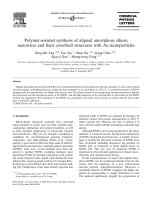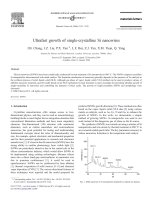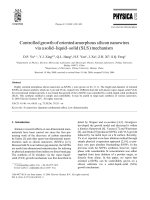- Trang chủ >>
- Khoa Học Tự Nhiên >>
- Vật lý
Rational growth of highly oriented amorphous silicon nanowire films
Bạn đang xem bản rút gọn của tài liệu. Xem và tải ngay bản đầy đủ của tài liệu tại đây (299.83 KB, 5 trang )
Rational growth of highly oriented amorphous
silicon nanowire films
Xihong Chen
1
, Yingjie Xing
1
, Jun Xu, Jie Xiang, Dapeng Yu
*
Department of Physics, School of Physics, State Key Laboratory for Mesoscopic Physics, Electron Microscopy Laboratory,
Peking University, Room 211, Building N, Beijing 100871, China
Received 10 April 2003; in final form 7 May 2003
Abstract
Amorphous silicon nanowire films were rationally synthesized using a simple approach. The films consist of highly
oriented nanowires of 30 lm in length and 20–80 nm in diameter. The morphology, microstructure features, and
chemical composition of the nanowires were analyzed using electron microscopy and Raman spectroscopy. A novel
model concerning solid–liquid–solid phases was proposed to explain the growth mechanism of the nanowires. This
approach should be very useful to direct the controlled growth of nanomaterials.
Ó 2003 Published by Elsevier Science B.V.
1. Introduction
One-dimensional nanomaterials have been a
focused research field since the first pioneering
work of the discovery of carbon nanotubes [1] and
nanowires [2–6]. A diverse variety of semiconduc-
tor nanowires, such as silicon, GaAs, GaN, and
ZnO nanowires, were synthesized using different
approaches. Of those nanowire materials, silicon
nanowires (SiNWs) have great scientific and
technological importance, and have attracted
much research interest [7,8]. For example, the sil-
icon nanowires have been used as the building
blocks to build nano-scale logic and computa-
tional circuits [9], nanodiodes, and random access
memory [10]. Controlled growth of the nanowires
in their morphology, orientation, for example, is
the key to success both for characterization of
physical properties and exploration of device ap-
plication of the nanowires; however, it is extremely
difficult to realize. In this Letter, we will report the
rational synthesis of highly oriented amorphous
SiNW films on centimetric substrates. The growth
mechanism was explained under a novel frame-
work of the solid–liquid–solid (SLS) mechanism.
2. Experimental
A conventional hot-filament CVD system was
modified to grow the silicon nanowires. A thin
layer of nickel 5 nm in thickness was deposited by
thermal evaporation on a 5 mm  5 mm p-type Si
Chemical Physics Letters 374 (2003) 626–630
www.elsevier.com/locate/cplett
*
Corresponding author. Fax: +8601062759474.
E-mail address: (D. Yu).
1
Authors contribute equally to the work.
0009-2614/03/$ - see front matter Ó 2003 Published by Elsevier Science B.V.
doi:10.1016/S0009-2614(03)00781-4
(1 1 1) wafer. Such a substrate was heated to about
900 °C for 10 min in the sample stage of the HF-
CVD system, while a H
2
gas flow was introduced
into the chamber at 20 sccm during the growth to
keep an ambient pressure about 1.5 kPa. The
original shiny surface of the substrate became gray
after cooling down to room temperature. The
morphology of the as-grown product was analyzed
using an scanning electron microscope (SEM,
DB235 FIB,FEI). A Hitachi-9000 NAR high-res-
olution transmission electron microscope (TEM)
equipped with nano-beam energy dispersive spec-
troscopy (EDS) was used to characterize the mi-
crostructure and chemical composition of the
nanowires. Raman spectrum was measured using
a Renishaw 2000 system with a laser source of
514.5 nm.
3. Results and discussions
In a brief view of SEM analysis, the whole
substrate was found to be covered with a thick
layer of wool-like product, as is shown in Fig. 1.
The wool-like layer with homogeneous thickness
can be easily scratched from the substrate, which is
marked with arrow in the SEM image. In the
magnified SEM image in the left inset, one piece of
the wool-like carpet was scratched from the sub-
strate and was folded on top of the film. The right
inset shows the details of the edge of the layer, and
reveals that the film consists of fine free-standing
wires of very high density, and has a thickness of
about 30 lm (also the length of the nanowires).
The growth rate of nanowires is faster than 100
nm/s. The catalyst nanoparticles were found at the
bottom of the a-SiNWs, which is marked with
arrow in the right inset, revealing a base growth of
the nanowires. Whether a base or a top growth
depend on the wetting condition between the cat-
alyst droplets and the substrate. If the wetting is
very good, the interaction force between the cat-
alyst droplets and the substrate can be very strong
and the nanoparticles will stay at the substrate as a
base growth; otherwise if the wetting is bad, a top
growth will work. In the present case, the wetting
between Si and Si
2
Ni should be good because the
silicon has a very large solubility in Si
2
Ni, so
the catalyst droplets should stay at the bottom of
the nanowires. We repeated the procedure several
times under a similar growth conditions and found
that the wool-like films were completely repro-
ducible. This demonstrates that our method is
controllable and easy to scale up.The SEM images
in Fig. 2 reveal that the nanowires are highly ori-
ented perpendicular to the substrate. As is seen
from the cross-sectional view along the edge of the
scratched film in Fig. 2a, the orientation of the
nanowires is widespread over the whole substrate.
Detailed SEM view in Fig. 2b shows that the
nanowires appear straight and parallel to each
other.
Part of the product was scratched off and used
to measure the Raman spectrum in a micro-beam
mode from different places of the sample. Two
peaks around 300 and 516 cm
À1
were observed, as
is shown in Fig. 3a. It is well known that those two
Raman peaks are characteristic of a silicon struc-
ture, corresponding to the second-order transverse
acoustic phonon mode (2TA), and the first-order
transverse optical phonon mode (TO) of silicon,
respectively. The Raman result confirmed that the
nanowire film is composed of silicon. The possi-
bility of the formation amorphous silicon oxide
Fig. 1. SEM image revealing a wool-like film on large area. The
SEM image in the left inset reveals that one sheet of the film was
scratched off the substrate. The film has a thickness about 30
micrometers, and consists of pure nanowires, as shown in the
right inset. The bright contrast indicated by an arrow shows the
catalyst layer between the substract and nanowire film, which
provides evidence for a base growth.
X. Chen et al. / Chemical Physics Letters 374 (2003) 626–630 627
nanowires can be excluded by the following dis-
cussions. Because the growth was conducted in a
steel CVD chamber, it guarantees a very good
vacuum status, and the hydrogen gas keeps a
reduction atmosphere. On the other hand, the
substrate we used is the commercial microelec-
tronic wafers having very thin native oxide layer
(usually <1 nm), which is not thick enough to
grow oxide nanowire layer as thick as 30 lm.
The microstructure and chemical composition
of the nanowires were also analyzed using TEM.
Fig. 3b shows a TEM image of the silicon nano-
wires. The diameter of the nanowires ranges from
20 to 80 nm. Selected-area electron diffraction
(SAED) reveals that the nanowires are amorphous.
The inset in the left shows the corresponding EDS
spectrum, which reveals that the nanowires are
mainly composed of silicon. The remaining oxygen
peak comes from the surface oxidation of the
nanowires. Nanosized particles larger than the
nanowire diameter were found attached to the end
of the nanowires, which is marked with an arrow in
the right inset. EDS analysis shows that the
nanoparticles were composed of both silicon and
nickel. Those nanoparticles can provide evidence
for the growth mechanism of the nanowires.
It was found that the growth mechanism of the
amorphous silicon nanowires (a-SiNWs) is differ-
ent from the conventional vapor–liquid–solid
(VLS) model [11,12]. The growth circumstances in
the present case are completely different from that
in laser ablation [2,3], or in the CVD method [8] in
which the silicon source is supplied directly from
the vapor phase. When the vapor phase plays an
important role, the growth of the SiNWs is mostly
controlled by the well-known VLS mechanism. In
the present circumstance, however, no Si vapor
phase is introduced into the system as in CVD
growth of SiNWs. Though the eutectic point of
Fig. 2. SEM images showing the high orientation of the nanowire films. (a) Edge of the film showing a wide-spread orientation of the
nanowires. (b) Details of the highly oriented nanowire film.
Fig. 3. (a) Raman spectrum of the nanowire film scratched off
from the substrate. Two peaks at 300 and 516 cm
À1
, were ob-
served which correspond to 2TA, and TO modes of silicon,
respectively. (b) TEM image showing the morphology of the
silicon nanowires. The inset in the left shows the EDS spectrum
and Si and O are visible, where oxygen comes from the surface
oxidation of the nanowires. The inset in the right shows a Si–Ni
nanoparticle capped at the end of the nanowire.
628 X. Chen et al. / Chemical Physics Letters 374 (2003) 626–630
Si
2
Ni is 993 °C, the small-size-melting effect makes
it possible for the deposited Ni nanoparticles to
react with the Si substrate at temperature above
900 °C, forming Si
2
Ni eutectic liquid droplets. So
the source materials comes from directly the sub-
strate instead from the vapor phase in the present
case. Therefore, we proposed a novel model to
explain the growth of the a-SiNWs, which involves
the SLS phases in the growth process. In the SLS
growth, the catalyst Ni dissolves directly the sili-
con substrate to form Si
2
Ni eutectic liquid phase in
the following reaction:
2Si ðsÞþNi ðsÞ!NiSi
2
ðlÞð1Þ
where s represents the solid phase and l the liquid
phase.
Because the silicon has a large solubility in the
Si
2
Ni liquid phase, more Si atoms will be dissolved
continuously into the liquid droplets. When the
liquid phase becomes supersaturated, the a-SiNWs
will grow out off the liquid droplets, which can be
represented as follows:
Si ðsÞþNiSi
2
ðlÞ!Si
super
Ni ðlÞ
! Si
2
Ni ðlÞþSi
w
ðsÞð2Þ
(super represents silicon supersaturation and w
represents the finally solidified SiNWs).
Since the silicon substrate was placed face up
directly on the hot filament to be heated from the
back, so the temperature gradient in the substrate
must be considerable. The temperature gradient
should be the driving force for the silicon substrate
to be dissolved to form low temperature Ni–Si
eutectic liquid phase, forming silicon nanowires at
the cooler side.
The SLS mechanism is in some extent an anal-
ogy to the VLS model. In the SLS controlled
growth of nanowires, the eutectic Ni–Si liquid
droplets have to stay at the surface of the silicon
substrate in order to grow continuously, and the
solidified nanoparticles shall remain at the bottom
of the nanowires, as is shown in the right inset in
the SEM image in Fig. 1. In this image, there exists
a bright-contrasted layer between the substrate
and the nanowires film (marked with an arrow),
and EDS analysis proved that this bright-con-
trasted layer consists of Si and Ni.
Two more questions shall be addressed here.
First, it is not well understood why the final
nanowires are in amorphous state instead of a
crystalline phase. The most possible explanation is
the unusual high growth rate. The estimated
growth rate is about 100 nm/s. Such a high growth
rate may explain why the resulting nanowires are
amorphous instead of crystalline, because the
growth is so rapid that the atoms have no time to
stack themselves into crystalline order. Second, we
think that the crowding effect between the very
dense nanowires plays an important role to keep
the nanowires staying oriented. From the SEM
images in the previous sections, it is also evident
that the density of the a-SiNWs is very high, so the
Van der Waals force between nanowires should be
large. This interaction force is another important
factor to keep the nanowires grow upward and to
be oriented towards each other.
The a-SiNWs grown on the substrate have re-
markable surface/volume ratio, and can show
physical/chemical properties completely different
from the bulk. In fact, it was recently revealed that
the lithium battery using SiNWs as electrode ma-
terials showed a capacity as high as eight times
that of the ordinary one [13]. Therefore, the
a-SiNWs may have potential applications such as
rechargeable battery of high capacity with por-
table size. The a-SiNWs can also be useful in
chemistry, biology, electronics and other fields on
consideration of their huge specific surface. Fur-
thermore, it is believed that the present rational
synthesis method can be used to direct the con-
trolled growth of other nanowire structures.
4. Conclusion
Highly oriented amorphous silicon nanowire
films have been synthesized rationally on large-
area silicon substrate via heat treatment of the
nickel-coated silicon substrate. The morphology,
microstructure, and chemical composition of the
nanowires were characterized using electron
microscopy and Raman spectroscopy. The growth
of the a-SiNWs cannot be explained by the con-
ventional VLS mechanism, and a novel SLS model
was proposed to explain reasonably the growth of
X. Chen et al. / Chemical Physics Letters 374 (2003) 626–630 629
the amorphous silicon nanowires. The as-grown
a-SiNWs and the proposed growth model should
be useful to direct the controllable growth of other
nanowire structures.
Acknowledgements
This project was financially supported by na-
tional Natural Science Foundation of China
(NSFC, No. 50025206, 20151002), and by the
Research Fund for the Doctoral Program of
Higher Education (RFDP), China.
References
[1] S. Iijima, Nature 354 (1991) 56.
[2] D.P. Yu, C.S. Lee, I. Bello, X.S. Sun, G.W. Zhou, Z.G. Bai,
Z. Zhang, S.Q. Feng, Solid State Commun. 105 (1998) 403.
[3] M. Morales, C.M. Lieber, Science 279 (1998) 208.
[4] X.F. Duan, J.F. Wang, C.M. Lieber, Appl. Phys. Lett. 76
(2000) 1116.
[5] W.Q. Han, S.S. Fan, Q. Li, Y. Hu, Science 277 (1997)
1287.
[6] Y.C. Kong, D.P. Yu, B. Zhang, W. Fang, S.Q. Feng, Appl.
Phys. Lett. 78 (2001) 407.
[7] J. Hu, M. Ouyang, P. Yang, C.M. Lieber, Nature 399
(1999) 48.
[8] J. Westwater, D.P. Gosain, S. Tomiya, S. Usui, H. Ruda,
J. Vac. Sci. Technol. B 15 (1997) 554.
[9] Y. Huang, X.F. Duan, Y. Cui, J. Lauhon, K.H. Kim, C.M.
Lieber, Science 294 (2001) 1313;
A. Bachtold, P. Hadley, T. Nakanishi, C. Dekker, Science
294 (2001) 1317.
[10] T. Rueckes, K. Kim, E. Joselevich, G.Y. Tseng, C.L.
Cheung, C.M. Lieber, Y. Cui, C.M. Lieber, Science 289
(2001) 94.
[11] R.S. Wagner, W.C. Ellis, Appl. Phys. Lett. 4 (1964) 8.
[12] E.I. Givargizov, J. Cryst. Growth 32 (1975) 20.
[13] G.W. Zhou, H. Li, H.P. Sun, D.P. Yu, Y.Q. Wang, L.Q.
Chen, Z. Zhang, Appl. Phys. Lett. 75 (1999) 2447.
630 X. Chen et al. / Chemical Physics Letters 374 (2003) 626–630

